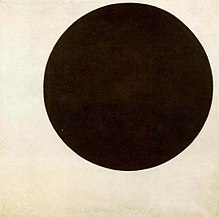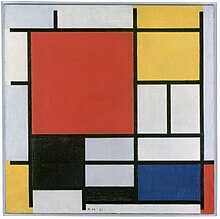Abstract art
Abstract art is a form of expression of artistic feelings that dispenses with all figuration and proposes a new reality different from the natural one. It uses a visual language of shape, color and line to create a composition that can exist independently of visual references from the real world. It encompasses movements such as abstract expressionism, suprematism, action painting, De Stijl or constructivism.
History
19th century
The first innovations in artistic approach are attributed to artists such as James McNeill Whistler who, in his painting Nocturne in Black and Gold: The falling Rocket, Falling", 1872), placed more emphasis on visual wonder than on the representation of objects. Likewise, an objective interest in what is seen appears in paintings by John Constable, J. M. W. Turner, Camille Corot and most of the plen air painters of the Barbizon school.
20th century
Paul Cézanne had started out as an Impressionist but his logical reconstruction of reality from different spatial points, using color to create modules and planes, became the basis for a new visual art that later developed into Georges Cubism. Braque and Pablo Picasso.
Expressionist painters explored the crude use of the pictorial surface, drawing distortions, exaggerations, and intense color. The Expressionists produced emotionally charged paintings that were reactions to and perceptions of contemporary experience; and reactions to impressionism and other more conservative directions of painting from the late XIX. Although artists such as Edvard Munch and James Ensor were mainly influenced by the work of the Post-Impressionists, they were instrumental in the advent of abstraction in the 20th century with works such as The Scream and The Entry of Christ into Brussels.
Post-Impressionism as practiced by Paul Gauguin, Georges Seurat, Vincent van Gogh and Paul Cézanne had an enormous impact on [[art of the century XX]] and led to the advent of XX century abstraction. The heritage of painters such as Van Gogh, Cézanne, Gauguin and Seurat was essential for the development of modern art. At the turn of the 20th century, Henri Matisse and other young artists including the pre-cubists Georges Braque, André Derain, Raoul Dufy and Maurice de Vlaminck revolutionized the art world of Paris with colorful and expressive paintings of "wild" landscapes and figures, which critics called fauvism. The crude language of color as developed by the Fauves directly influenced another pioneer of abstraction, Wassily Kandinsky.
Although cubism ultimately depends on the subject represented, it was together with fauvism the artistic movement that directly opened the door to abstraction in the 19th century XX. Pablo Picasso made his first cubist works based on Cézanne's idea that all representation of nature can be reduced to three solids: cube, sphere and cone. With the 1907 painting Les Demoiselles d'Avignon, Picasso dramatically created a radical new painting depicting a crude, primitive brothel with five prostitutes, violently painted women reminiscent of African tribal masks and his new cubist creations. Analytical Cubism was developed jointly by Pablo Picasso and Georges Braque, from around 1908 to 1912. Analytical Cubism, the first clear manifestation of Cubism, was followed by Synthetic Cubism, practiced by Braque, Picasso, Fernand Léger, Juan Gris, Albert Gleizes, Marcel Duchamp and countless other artists around the twenties. Synthetic cubism is characterized by the introduction of different textures, surfaces, elements of collage, papier collé and a great variety of united objects. Collage artists such as Kurt Schwitters and Man Ray and others influenced by Cubism were instrumental in the development of the movement called Dadaism.
Since the turn of the century, cultural connections between artists in major European and North American cities had become extremely active as they strove to create an art form that matched the high aspirations of modernism. Ideas were able to influence each other through artists' books, exhibitions, and manifestos so many sources were open to experimentation and formed the basis for the diversity of modes of abstraction. The following excerpt, from The World Backwards, provides some impression of the interconnectedness of culture at the time:
David Burliuk's knowledge of modern art movements must have been extremely updated, as the second exhibition of the movement Diamond Sota, held in January 1912 (in Moscow) included not only paintings sent from Munich, but some members of the German group Die Brücke, while from Paris came works by Robert Delaunay, Henri Matisse and Fernand Léger, as well as by Picasso. During the spring David Burliuk gave two lectures on Cubism and planned a controversial publication, which Diamond Sota I was going to finance. He went abroad in May and returned determined to rival the Almanaque Der Blaue Reiter who had emerged from the printers while he was in Germany.
Music
Some approaches to abstract art had connections to music. Music provides an example of an art form that uses the abstract elements of sound and the divisions of time. Wassily Kandinsky himself, who was also a musician, was inspired by the possibility of markings and associative color resonating in the soul. The idea had been proposed by Charles Baudelaire, that all our senses respond to various stimuli but the senses are connected on a deeper aesthetic level.
Intimately related to this is the idea that art has The spiritual dimension and can transcend everyday life, reaching a spiritual plane. The Theosophical Society popularized the ancient wisdom of the sacred books of India, China in the early years of the century. It was in this context that Piet Mondrian, Wassily Kandinsky, Hilma af Klint, and other artists working towards the "objectless state" became interested in the occult as a way of creating an "inner" object. The universal and timeless forms found in geometry: the circle, the square, and the triangle became spatial elements in abstract art; they were, like color, fundamental systems below visible reality.
Lyrical abstraction
Chronologically, the Lithuanian Mikalojus Konstantinas Čiurlionis is considered, for his non-figurative compositions dated 1904, as the first abstract painter. But abstraction as a coherent international modern style saw its true foundations laid by Wassily Kandinsky. His work illustrates the so-called lyrical abstraction. He arrived, between 1910 and 1912, at an abstraction impregnated with feeling, ideally representative of the aspirations of the artists of the Munich expressionist group Der Blaue Reiter, of which he himself was a part. Beginning in 1912, almost all European artists experimented along these lines.
By 1911, many experimental works had been created that sought “pure art”. In France, Robert Delaunay developed, from 1912, on the basis of Chevreul's theories on the simultaneous contrast of colors, his Windows and his first abstract Cosmic Circular Forms, while that Frank Kupka exhibited at the Salon d'Automne in 1912 Amorphous, Fugue of Two Colors and in 1913 Blue and Red Vertical Planes. In 1913 the poet Guillaume Apollinaire called the work of Robert and Sonia Delaunay Orphism. He defined it as the art of painting new structures from elements that have not been borrowed from the visual sphere, but have been totally created by the artist...it is pure art.
Russian Vanguard
At the same time, in Russia, Mikhail Larionov and Natalia Goncharova brought their method of transcribing the luminous phenomenon to pure abstraction, which they called rayonism (Luchizm). His drawings used lines like rays of light to make a construction. Many of the abstract artists in Russia became constructivists believing that art was no longer something remote, but life itself. The artist was to become a technician, learning to use the tools and materials of modern production. Art to life! was the slogan of Vladimir Tatlin, and of all future constructivists. Varvara Stepanova and Aleksandra Ekster and others abandoned easel painting and turned their energies to theater design and graphic work.
Kazimir Malevich completed his first fully abstract work, the Suprematist, Black Square in 1915. Another member of the Suprematist group, Liubov Popova, created the Architectural Constructions and Spatial Force Constructions between 1916 and 1921. Malevich, Anton Pevsner, and Naum Gabo argued that art was essentially a spiritual activity; to create the individual's place in the world, not to organize life in a materialistic and practical sense. Many of those who were hostile to the idea of materialistic art production left Russia. Anton Pevsner went to France, Gabo went first to Berlin, then to England, and finally to the United States. Wassily Kandinsky studied in Moscow then went to the Bauhaus. By the mid-1920s the revolutionary period (1917-1921) when artists had been free to experiment was over; and by the 1930s only social realism art was allowed.
Other abstractions
In 1906 the Swedish artist Hilma af Klint (1862-1944), a pioneer of abstract art, created the series Paintings for the Temple in which they deal with spirituality, the evolution of the human being and the religions of the world. The artist's work was not made public until 1986, twenty years after her death, at the express wish of Klint who considered that her work would not be understood by the public.
Piet Mondrian evolved his abstract language, of horizontal and vertical lines with colored rectangles, between 1915 and 1919. Neoplasticism was the aesthetic that Mondrian, Theo van Doesburg and others from the De Stijl group sought to reform the medium of the future. In Italy Futurism, mixed with the Bauhaus influence, led the way towards abstract art with a distinctively warm color palette as in the works of Manlio Rho and Mario Radice.
In the interwar period (1918-1939), Theo van Doesburg, after having been one of the main defenders of Neo-Plasticism, decisively renewed abstract art by maintaining that artistic creation should only be subject to controllable rules and logical, thus excluding any subjectivity.
The manifesto of concrete art, which he published in Paris in 1931, gave rise to the trend of the same name that had a great development in Switzerland with Max Bill and Richard Paul Lose, in France with François Morellet, and in all systematic art forms born after the war. These tendencies then entered into competition with the various tacho and gestural currents (Jean Bazaine, Alfred Manessier, Pierre Soulages and Georges Mathieu, among others) that the critic Michel Tapié regrouped under the name of informal art.
The abstract tradition experienced an important renaissance in the United States beginning in the late 1940s with Action Painting (Jackson Pollock, Willem de Kooning, Franz Kline) and Colour-Field Painting (Barnett Newman, Mark Rothko, Clyfford Still).
These trends were superseded from 1960 by the appearance of minimalist art, which marked a new period of interest in geometry and structure while in Europe and Latin America Op Art and kinetic art knew their glory hours (Yaacov Agam, Jesús Soto, Carlos Cruz-Diez, Victor Vasarely, Nicolas Schöffer and Bridget Riley, among others).
The end of the 1960s saw the development of an abstraction centered on the analysis of its own components, with the BMPT and Support(s)-Surface(s) groups in France, or oriented towards definition problems of the nature of the image with Sigmar Polke and Gerhard Richter in Germany. The neo-expressionist and neo-geometric trends that emerged during the 1980s showed a new period of interest in abstraction, which continues to be adopted to this day by many artists, such as Ian Davenport, Juan Uslé, Pablo Rey and Jan Maarten Voskuil., inspired by the most varied motivations.
Contenido relacionado
Auferstanden aus Ruinen
Donnie Darko
History of the comic in Spain



